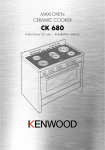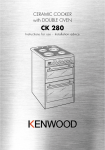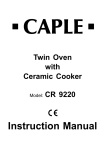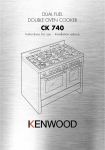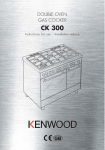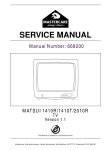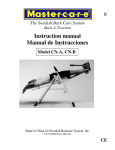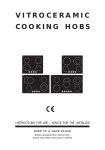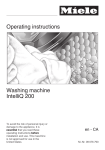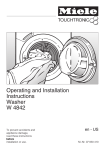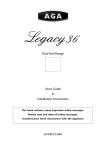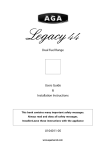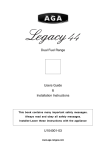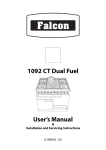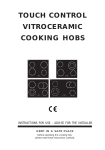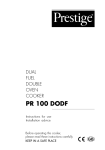Download Kenwood CK 780 User's Manual
Transcript
DOUBLE OVEN CERAMIC COOKER CK 780 Instructions for use - Installation advice 2 CONTENTS Introduction . . . . . . . . . . . . . . . . . . . . . . . . Important Safeguards & Recommendations . . . Cooking Hob Key . . . . . . . . . . . . . . . . . . . . Control Panel . . . . . . . . . . . . . . . . . . . . . . . How to use the cooking hob . . . . . . . . . . . . . How to use the multi-function oven. . . . . . . . . How to use the conventional oven . . . . . . . . . How to use and set the electronic programmer . Cleaning & maintenance. . . . . . . . . . . . . . . . . . . . . . . . . . . . . . . . . . . . . . . . . . . . . . . . . . . . . . . . . . . . . . . . . . . . . . . . . . . . . . . . . . . . . . . . . . . . . . . . . Page . . . . . . . . . . . . . . . . . . . . . . . . . . . . . . . . . . . . Number 4 - 5 6 - 7 8 9 10 - 14 15 - 20 21 - 26 27 - 30 31 - 34 Advice For The Installer . . . . . . . . . . . . . . . . . . . . . . . . . . . . 35 Installation . . . . . . . . . . . . . . . . . . . . . . . . . . . . . . . . . . . . . . 36 - 39 Electrical installation . . . . . . . . . . . . . . . . . . . . . . . . . . . . . . . 40 - 41 Service & Guarantee . . . . . . . . . . . . . . . . . . . . . . . . . . . . . . . 43 3 Dear Customer, Thank you for purchasing a Kenwood Double Oven Ceramic Cooker. The safety precautions and recommendations in these instructions are for your own safety and that of others. They will also provide a means by which to make full use of the features offered by your appliance. Please keep this booklet in a safe place. It may be useful in the future, either to yourself or to others in the event that doubts should arise relating to its operation. This appliance must be used only for its intended purpose , that is for the domestic cooking of foodstuffs. Any other form of usage is to be considered as inappropriate and therefore dangerous. The manufacturer declines all responsibility in the event of damage caused by improper, incorrect or illogical use of the appliance. 4 This cooker has been designed, constructed and marketed in compliance with: - safety requirements of EEC Directive “Low voltage” 73/23; - protection requirements of EEC Directive “EMC” 89/336; - requirements of EEC Directive 93/68. GB Read the instructions carefully before installing and using the appliance. FIRST USE OF THE OVEN Follow the instructions below: – Furnish the interior of the oven by placing the wire racks as described in “Cleaning and maintenance”. – Insert shelves and tray. – Switch the empty oven on to max to eliminate grease from the heating elements. See pages 15 and 21. – Let the oven cool down and clean the interior of the oven with a cloth soaked in water and neutral detergent, then dry carefully. 5 I M P O R TA N T S A F E G U A R D S A N D R E C O M M E N D AT I O N S ● ATTENTION: please peel the plas- objects. Don't use the hob as a work surface. ● Do not use a steam cleaner tic cover off both the sides and front of the oven before use. because the moisture can get into the appliance thus making it unsafe. ● After use, always ensure that the ● The manufacturer declines all liability knobs are in the “off” position. ● Do not allow children or infirm per- sons to use the appliance without your supervision. ● During and after use of the cooker, certain parts will become very hot. Do not touch hot parts. ● Keep children away from the cook- er when it is in use. ● Some appliances are supplied with a protective film on steel and aluminium parts. This film must be removed before using the appliance. ● Fire risk! Do not store flammable material in the oven or in the storage compartment. ● Make sure that electrical cords con- for injury to persons or damage to property caused by incorrect or improper use of the appliance. ● The various components of the appli- ance are recyclable. Dispose of them in accordance with the regulations in force in your country. If the appliance is to be scrapped, cut off the power cord. ● Always use oven gloves when remov- ing the shelves and food trays from the oven whilst hot. ● Do not hang towels, dishcloths or other items on the cooker or its handle - as this could be a fire hazard. ● Clean the oven regularly and do not allow fat or oils to build up in the oven base or trays. Remove spillages as soon as they occur. necting other appliances in the proximity of the cooker cannot come into contact with the hob or become entrapped in the oven door. ● Do not stand on the cooker or on the ● Do not line the oven walls with alu- ● Always stand back from the cooker minium foil. Do not place baking trays or the drip tray on the base of the oven chamber. when opening the oven door to allow steam and hot air to escape before removing the food. ● Do not allow heavy or sharp objects to drop on the glass ceramic hob. If the hob is cracked or otherwise damaged by falling objects etc., disconnect the electrical power cord and call after-sales service. 6 ● Do not scratch the hob with sharp open oven door. IMPORTANT: This appliance is designed solely for the cooking of domestic food and is not suitable for commercial use. This appliance incorporates a safety cooling fan which can be heard when the oven or grill are operating. USEFUL HINTS After removing the appliance from its packing, make sure of its integrity. In case of doubt, please contact your supplier or a qualified engineer. The packing materials (plastic bags, polyfoam, nails, metal strips etc.) must not be left around in easy reach of children as they may cause serious injury. – Do not attempt to alter the technical features of the appliance as this may result in danger to the user. – Do not carry out any cleaning or maintenance without first disconnecting of the appliance from the electric supply. – Whenever you decide to get rid of this appliance (in case of replacement with a new one), before scrapping it is recommended to render it inoperative and harmless in respect of health and antipollution regulations. 7 1 - COOKING HOB 2 4 3 1 6 5 Fig. 1.1 VITROCERAMIC COOKING HOB 1. 3 circuits cooking zone Ø 180 2. 3 circuits cooking zone Ø 145 3. Oval cooking zone Ø 145 x 250 4. Double cooking zone Ø 210/120 5. 3 circuits cooking zone Ø 145 6. Cooking zone residual heat indicators 1700 W 1200 W 1800/1000 W 2100/700 W 1200 W Attention: Disconnect the appliance from the mains if the ceramic hobs is cracked. 8 2 - CONTROL PANEL Fig. 2.1 A U T O 8 7 11 6 5 4 13 3 2 1 10 12 9 CONTROL PANEL - Controls description 1. Front right cooking zone control knob 2. Rear right cooking zone control knob 3. Central cooking zone control knob 4. Rear left cooking zone control knob 5. Front left cooking zone control knob 6. Multifunction main oven switch knob 7. Multifunction main oven temperature knob 8. Electronic programmer 9. Conventional oven temperature knob 10. Conventional oven switch knob Pilot lamps: 11. Main oven temperature indicator light 12. Conventional oven temperature indicator light 13. Ceramic hob ON indicator light 9 3 - USE OF COOKING HOB The ceramic surface of the hob allows a fast transmission of heat in the vertical direction, from the heating elements underneath the ceramic glass to the pans set on it. The heat does not spread in a horizontal direction, so that the glass stays “cool” at only a few centimeters from the cooking plate. 3 CIRCUIT RADIANT ZONES Incorporating 3 heating elements (fig. 3.2) you can control and light up all 3 together or separately by selecting from the 6 positions on the control knob (fig. 3.1). The working temperature required is reached in a very short time. The 5 cooking zones are shown by painted disks on the ceramic surface. 2 5 6 1 4 Fig. 3.1 3 10 fig. 3.2 DOUBLE AND OVAL RADIANT ZONES 1 12 2 11 The heating element is formed of a coil of resistant material which reaches the working temperature quickly. Operation of the cooking zone is controlled by a continuous energy regulator from “1” to “12” (maximum temperature) (fig. 3.3). 3 4 9 7 6 5 Second element 8 Fig. 3.3 fig. 3.4 10 By switching on the second element (fig. 3.4 and 3.5), the surface area of the rear right and central radiant zones can be extended. For this purpose, turn the control knob (fig. 3.3) fully to the right (position ). Second element fig. 3.5 11 CO0KING HINTS Cooking plate controlled by a 6 position switch Cooking plate controlled by a 12 position switch Knob setting TYPE OF COOKING 0 0 Switched OFF 1 2 1 2 For melting operations (butter, chocolate). 2 2 3 4 To keep food hot and to heat small quantities of liquid (sauces, eggs). 3 4 5 6 To heat bigger quantities; to whip creams and sauces. (vegetables, fruits, soups). 3 4 6 7 Slow boiling, i.e.: boiled meats, spaghetti, soups, continuous steam cooking of roasts, stews, potatoes. 4 7 8 For every kind of frying, cutlets, uncovered cooking, i.e.: risotto. 4 5 8 9 10 Browning of meats, roasted potatoes, fried fish, omelettes, and for boiling large quantities of water. 6 11 12 Fast frying, grilled steaks, etc. 1 1 2 3 2 4 5 3 6 7 4 8 9 10 5 11 12 6 Heating Switching on the second element (Double and oval radiant plate only) Cooking Roasting-frying 12 Fig. 3.6 After a short period of use, experience will teach you which setting is the right one for your needs. RESIDUAL HEAT INDICATOR COOKING HINTS: The hob also features 5 warning lights which are connected to the corresponding plate. – To reduce the cooking time, you can turn the control knob to the max when you switch the plate on. After a short time you can set the control knob to the position required for cooking. When the temperature of a cooking plate is above 60°C, the relevant warning light will also light up to warn of heat on the surface of the hob. This light also stay on after the cooking plate has been switched off to show that the hob surface is still hot. This residual heat will lasts for a long time after the cooking plate has been switched off. During this time you should avoid touching the hob surface over the cooking area. Please pay special attention to ensure that children are not allowed near the hob. The light will switch off automatically as soon as the surface temperature of the cooking plate falls below 60°C. Caution! the cooking hob becomes very hot during operation. Keep children well out of reach. – You should only use pots and pans with flat bases (pans with the test mark for glass-ceramic hobs are available from specialist shops). The diameter of the pan should match that of the cooking plate (or be slightly bigger) to make the most of the energy. – Since the cooking surface will stays hot for a certain time after the plate has been switched off, you can switch it off 5 or 10 minutes before the end of the cooking. The residual heat of the hob will complete the cooking. – To save electricity, use pan lids whenever possible. – Never cook the food directly on the glass ceramic cooktop. DEEP FAT FRYING For safety purposes when deep fat frying, do not fill the pan more than one third full of oil. DO NOT cover the pan with a lid and DO NOT leave the pan unattended. In the unfortunate event of a fire, leave the pan where it is and turn off the control knobs. Place a damp cloth or lid over the pan to smother the flames. Leave the pan to cool for at least 30minutes before moving the pan. DO NOT USE WATER ON THE FIRE. Fig. 3.7 13 SAFETY HINTS: CLEANING – Before you switch the hob on, make sure you know which knob controls the required cooking plate. We advise you to set the pan over the cooking plate before switching it on. Remove the pan after you have switched the cooking plate off. – Do not use pots and pans with rough bases (pay attention to cookware made of cast-iron). Rough bases can damage (scratch) the glass surface of the hob. Make sure that the pan bottom of the pan is dry and clean. – Pots with aluminium bottoms may leave silver streaks or spots on the hob. – Do not leave wet or damp lids on the hob. – The glass-ceramic surface and pans must be clean. Carefully remove any food debris (especially containing sugar), dirt etc. with the aid of a cleansing agent. – Pan handles should never stand out beyond the kitchen worktop, as there is a great danger of knocking the pan over. This will also ensure that children cannot reach them. – Do not use the hob if the glass surface is broken or cracked in any way. Please disconnect the hob from the mains and contact the after-sales service. – Do not lean over the cooking plate when in use. – Do not lay cooking foil or plastic materials on the ceramic surface when it is hot. – Remember that the surface remains hot for a long time (about 30 min.) after the cooking plate has been switched off. – Follow the cleaning instructions carefully. Before you begin cleaning make sure that the appliance is switched off. Do not use the glass surface for storage. 14 Remove spillages and other types of incrustations. Dust or food particles can be removed with a damp cloth. If you use a detergent, please make sure that it is not abrasive or scouring. Abrasive or scouring powders can damage the glass surface of the hob. All traces of the cleaner must be removed with a damp cloth. Do not put articles on the hob which can melt: i.e plastic, aluminium foil, sugar, sugar syrup mixtures etc. If any of these products items have melted on the ceramic surface, you should remove it immediately (when the surface is still hot) by using a scraper to avoid any permanent damage to the surface of the hob. Avoid using a knife or other sharp utensils since these can damage the ceramic. Do not use steel wool or an abrasive sponge which could scratch the surface permanently. ATTENTION: MOST IMPORTANT! If cleaning the glass ceramic hob using a special scraper tool take extra care to avoid damaging to the seal at the edges of the glass ceramic surface. Fig. 3.8 4 - MULTI-FUNCTION MAIN OVEN Attention: the oven door becomes very hot during operation. Keep children away. Heating and cooking in the MULTIFUNCTION oven are obtained in the following ways: a. by normal convection The heat is produced by the upper and lower heating elements. GENERAL FEATURES The multi- function oven can be programed for 7 different functions to satisfy every cooking need. The 7 positions are thermostatically controlled and are obtained by a combination of 4 heating elements which are: – Bottom element – Top element – Grill element – Circular element OPERATING PRINCIPLES 2050 W 1250 W 2200 W 2500 W NOTE: Upon first use, it is advisable to operate the oven for 30 minutes in the position and for another 30 minutes at maximum (temperature knob on position 225) in the positions , to eliminate possible and traces of grease on the heating elements. Clean the oven and accessories with warm water and washing-up liquid. b. by forced convection The circular heating element and fan constantly circulate heated air over the food in the oven for a more rapid and even cooking process. It is possible to cook several dishes simultaneously. c. by semi-forced convection The heat produced by the upper and lower heating elements is distributed throughout the oven by the fan. d. by radiation The heat is irradiated by the infra red grill element. e. by radiation and ventilation The irradiated heat from the infra red grill element is distributed throughout the oven by the fan. f. by ventilation The food is defrosted by using the fan only function without heat. WARNING: The door is hot, use the handle. 15 50 75 100 250 200 1 25 225 175 150 Fig. 4.1 TEMPERATURE KNOB (fig. 4.2) To turn on the heating elements of the oven, set the switch knob on the desired program and select the required temperature. To set the temperature, line up the temperature knob indicator with the required temperature. The elements will turn ON or OFF automatically according to the energy need which is determined by the thermostat. Fig. 4.2 FUNCTION SELECTOR KNOB (fig. 4.1) Rotate the knob clockwise to set the oven for one of the following functions: OVEN LIGHT By setting the knob to this position, only the oven light comes on (15 W). The light remains on whilst any of the cooking modes are selected. TRADITIONAL CONVECTION COOKING The upper and lower heating elements are switched on. The heat is diffused by natural convection and the temperature must be set between 50° C and 225° C. It is necessary to preheat the oven before adding the foods to be cooked. Recommended for: For foods which require the same cooking temperature both internally and externally, i. 16 e. roasts, spare ribs, meringue, etc. GRILLING The infra-red heating element is switched on. The heat is diffused by radiation. Use with the oven door closed and the temperature knob between 50° and 225°C for a maximum of 15 minutes. Note: It is recommended that you do not grill for longer than 30 minutes at any one time. Attention: the oven door becomes very hot during operation. Keep children away. For correct use see “USE OF THE GRILL” Recommended for: Intense grilling action for cooking with a broiler; browning, crisping, “au gratin”, toasting, etc. DEFROSTING FROZEN FOODS Only the oven fan is on. To be used with the temperature knob on “●” because the other positions will have no effect. The defrosting is done by simple ventilation without heat. Recommended for: To rapidly defrost frozen foods; 1 kilogram requires about one hour. The defrosting times vary according to the quantity and type of foods to be defrosted. HOT AIR COOKING The circular element and the fan are on. The heat is diffused by forced convection and the temperature must be set between 50° and 225 °C. It is not necessary to preheat the oven. Recommended for: For foods that must be well done on the outside and tender or rare on the inside, i. e. lasagna, lamb, roast beef, whole fish, etc. 17 VENTILATED GRILL COOKING The infra-red ray grill and the fan are on. The heat is mainly diffused by radiation and the fan then distributes it throughout the oven. The temperature must be set between 50° and 175 °C for max 30 minutes. It is necessary to preheat the oven for about 5 minutes. Use with the oven door closed. Attention: the oven door becomes very hot during operation. Keep children away. For correct use see “GRILLING AND “AU GRATIN”. Recommended for: For grill cooking when a fast outside browning is necessary to keep the juices in, i. e. veal steak, steak, hamburger, etc. THAWING AND WARMING UP The upper element and the circular element connected in series, are switched on; also the fan is on. The heat is diffused by forced convection with the most heat being produced by the upper element. The temperature must be set between 50° and 140 °C. Recommended for: To keep foods hot after cooking. To slowly heat already cooked foods. CONVECTION COOKING WITH VENTILATION The upper and lower heating elements and the fan turn on. The heat coming from the top and bottom is diffused by forced convection. The temperature must be set between 50° and 225 °C. Recommended for: For foods of large volume and quantity which require the same internal and external degree of cooking; for ie: rolled roasts, turkey, legs, cakes, etc. 18 COOKING ADVICE GRILLING AND “AU GRATIN” OVEN COOKING Before introducing the food, preheat the oven to the desired temperature. For a correct preheating operation, it is advisable to remove the tray from the oven and introduce it together with the food, when the oven has reached the desired temperature. ROASTING To obtain classical roasting, it is necessary to remember: – that it is advisable to maintain a temperature between 180 and 200 °C. – that the cooking time depends on the quantity and the type of foods. Set the switch to position . Set the temperature knob to 175 °C and after having preheated the oven, simply place the food on the shelf. Close the door and let the oven operate until grilling is complete. Adding a few dabs of butter before the end of the cooking time gives the golden “au gratin” effect. Note: It is recommended that you do not grill for longer than 30 minutes at any one time. ATTENTION: the oven door becomes very hot during operation. Keep children away. USE OF THE GRILL SIMULTANEOUS COOKING OF DIFFERENT FOODS The MULTI-FUNCTION oven set on position gives simultaneous and cooking of different foods. Different foods such as fish, cake and meat can be cooked together without mixing the smells and flavours. This is possible since the fats and vapors are oxidized while passing through the electrical element and therefore are not deposited onto the foods. The only precautions to follow are: – The cooking temperatures of the different foods must be as close to as possible, with a maximum difference of 20° - 25 °C. – The introduction of the different dishes in the oven must be done at different times in relation to the cooking times of each one. This type of cooking saves energy. Preheat the oven for about 5 minutes. Introduce the food to be cooked, positioning the rack as close to the grill as possible. The drip tray should be placed under the rack to catch the cooking juices and fats. Grill with the oven door closed. Do not grill for longer than 30 minutes at any one time. CAUTION: the oven door becomes very hot during operation. Keep children well out of reach. time and 19 COOKING GUIDE Temperature and times given are approximate, as they will vary depending on the quality and amount of food being cooked. Remember to use ovenproof dishes and to adjust the oven temperature during cooking if necessary. COOKING CHART Food CAKES Victoria Sandwich Small cakes/buns Rich Fruit Cake Scones Whisked Sponge BREAD & PASTRY Bread Loaf (500g Flour wt) Bread Rolls Pizza Dough Shortcrust pastry Quiches/Flans ROAST MEATS Beef – medium joint Lamb Pork Chicken Turkey Stews/Casseroles Temperature °C Gas Mark Cooking Time (approx) 180 180 150 220 190 4 4 2 7 – 8 5 20 – 25 mins 15 – 20 mins 2 hours 8 – 10 mins 25 mins 225 225 225 200 180 - 190 7 – 8 7 – 8 8 6 4 - 5 20 10 15 20 30 190 190 190 190 180 170 5 5 5 5 4 3 – – – – – 25 mins 15 mins 20 mins 30 mins 40mins 20 – 25 mins/lb + 20mins 25 – 30mins/lb + 25mins 30mins/lb + 30mins 20 – 25mins/lb + 30mins 15 – 20mins/lb + 20mins 11/2 - 2hours NOTE: Reduce the oven temperature by 10 – 20°C for fan assisted ovens. For dishes that take over an hour to cook, reduce the cooking time by 10 minutes per hour. 20 5 - CONVENTIONAL OVEN Attention: the oven door becomes very hot during operation. Keep children away. GENERAL FEATURES The conventional oven has 3 heating elements which are: – Top element 700 W – Bottom element 800 W – Grill element 1600 W NOTE: Upon first use, it is advisable to operate the oven for 30 minutes in the position and for another 30 minutes at the maximum (temperature knob on position 250) in the position , to eliminate possible traces of grease on the heating elements. Clean the oven and accessories with warm water and washing-up liquid. This oven is equipped with a special dish rack for use with the special “PLATE WARMING” function. In this setting you can use your conventional oven to warm the plates (at about 60°C) before serving dinner. For correct use of this function see “PLATE WARMING or TRADITIONAL CONVECTION COOKING” and “USE OF SPECIAL DISH RACK”. WARNING: The door is hot, use the handle. 21 50 200 5 12 225 100 250 175 150 Fig. 5.1 Fig. 5.2 FUNCTION SELECTOR KNOB (fig. 5.1) TEMPERATURE KNOB (Fig. 5.2) Rotate the knob clockwise to set the oven for one of the following functions. This only sets the cooking temperature and does not switch the oven on. Rotate clockwise until the required temperature is reached (from 50 to 250°C). The light above the function selector will illuminate when the oven is switched on and turns off when the oven reaches the correct temperature. The light will cycle on and off during cooking in line with the oven temperature. OVEN LIGHT By setting the knob to this position the oven light will come on. (15 W). The light remains on whilst any of the functions are selected. TRADITIONAL CONVECTION COOKING The upper and lower heating elements are switched on. The heat is diffused by natural convection and the temperature must be set between 50° C and 250° C. It is necessary to preheat the oven before introducing the foods to be cooked. Recommended for: For foods which require the same cooking temperature both internally and externally, i. e. roasts, spare ribs, meringue, etc. 22 PLATE WARMING The upper and lower heating elements are switched on; the heat is diffused by natural convection. The temperature knob must be set to position to heat the plates at about 60°C. This function can also be used for traditional convection cooking: the temperature knob must be set between 50 and 250°C. Recommended for: Dish warming using the special rack. For correct use see “USE OF SPECIAL DISH RACK”. KEEP ATTENTION: Plates are hot after warming. It is advisable to handle the plates using oven gloves. SPIT ROASTING The infrared grill element at the top of the oven and the rotisserie motor comes on. The heat is dispersed by radiation. Use with the oven door closed, the function knob set to , and the temperature knob to 225°C for max 15 minutes, then to 175°C. For cooking hints, see “USE OF THE ROTISSERIE”. Attention: the oven door becomes very hot during operation. Keep children away. Recommended for: Spit roasting with the rotisserie. GRILLING The infrared grill element at the top of the oven comes on. The heat is dispersed by radiation. Use with the oven door closed, the function knob set to , and the temperature knob to position 225°C for max 15 minutes, then to position 175°C. For cooking hints, see “USE OF THE GRILL”. Attention: the oven door becomes very hot during operation. Keep children away. Recommended for: Intense grilling, browning, cooking au gratin and toasting etc. 23 COOKING GUIDE Temperature and times given are approximate, as they will vary depending on the quality and amount of food being cooked. Remember to use ovenproof dishes and to adjust the oven temperature during cooking if necessary. COOKING CHART Food CAKES Victoria Sandwich Small cakes/buns Rich Fruit Cake Scones Whisked Sponge BREAD & PASTRY Bread Loaf (500g Flour wt) Bread Rolls Pizza Dough Shortcrust pastry Quiches/Flans ROAST MEATS Beef – medium joint Lamb Pork Chicken Turkey Stews/Casseroles 24 Temperature °C Gas Mark Cooking Time (approx) 180 180 150 220 190 4 4 2 7 – 8 5 20 – 25 mins 15 – 20 mins 2 hours 8 – 10 mins 25 mins 225 225 225 200 180 - 190 7 – 8 7 – 8 8 6 4 - 5 20 10 15 20 30 190 190 190 190 180 170 5 5 5 5 4 3 – – – – – 25 mins 15 mins 20 mins 30 mins 40mins 20 – 25 mins/lb + 20mins 25 – 30mins/lb + 25mins 30mins/lb + 30mins 20 – 25mins/lb + 30mins 15 – 20mins/lb + 20mins 11/2 - 2hours USE OF THE GRILL ROTISSERIE (Fig. 5.3) The oven is equipped with a rotisserie for spit roast cooking using the grill. The rotisserie consists of: – an electrical motor mounted on the rear part of the oven – stainless steel spit with a removable stay-cool handle and two adjustable sets of prongs – spit support to be inserted in the central guide of the oven. The rotisserie motor is operated by the switch knob on grill position . Preheat the oven for about 5 minutes. Introduce the food to be cooked, positioning the rack as close to the grill as possible. The drip tray should be placed under the rack to catch the cooking juices and fats. USE OF THE ROTISSERIE OVEN COOKING Before introducing the food, preheat the oven to the desired temperature. For a correct preheating operation, it is advisable to remove the tray from the oven and introduce it together with the food, when the oven has reached the desired temperature. Grill with the oven door closed. Do not grill for longer than 30 minutes at any one time. Caution: the oven door becomes very hot during operation. Keep children well out of reach. – Insert the tray into the lowest rack holders of the oven and insert the rod support into the intermediate rack holders (fig. 5.3). – Put the meat to be cooked onto the rod, being careful to secure it in the center with the special forks. – Insert the rod into the motor opening and rest it onto the support of the spit collar; then remove the grip by turning it to the left. Grill with the oven door closed. Attention: the oven door becomes very hot during operation. Keep children away. It is recommended that you do not grill for longer than 30 minutes at any one time. 25 USE OF SPECIAL DISH RACK This special shelf can be used as a dish rack or when turned over, as a normal shelf for oven cooking. It must be inserted between the guides of the lateral racks. USING THE SPECIAL RACK FOR NORMAL COOKING Slide in the shelf on the guides: the safety catch must be turned toward the oven base (see detail of figure 5.5). The flat surface can be used to put cooking pans or to put food directly on the rack; in the second case the drip tray should be placed under the rack to catch the cooking juices and fats. USING THE SPECIAL SHELF AS A DISH RACK Slide in the shelf on the guides, on the lower level of the lateral racks. The prongs where the plates are to be inserted must be turned upwards. The shelf must be fitted so that the safety catch, which stops it sliding out, faces the bottom of the oven (see detail of figure 5.4). The plates must be positioned as indicated in figure 5.4. To facilitate this operation pull the special rack up to the safety lock. KEEP ATTENTION: Plates are hot after warming. It is advisable to handle the plates using oven gloves. 26 Fig. 5.4 Fig. 5.5 6 - ELECTRONIC PROGRAMMER The electronic programmer performs the following functions: – 24 hours clock with illuminated display – Timer (up to 23 hours and 59 minutes) – Program for automatic oven cooking – Program for semi-automatic oven cooking. Description of the illuminated symbols: AUTO - flashing - Programmer in automatic position but not programmed AUTO - always lit - Programmer in automatic position with program set. Automatic cooking taking place Timer in operation Description of the buttons: Timer Cooking time End of cooking time Manual position and cancellation of the set cooking program Advance the time for of all programs Decrease the program time and changing the frequency of the audible signal. and AUTO - flashing - Program error. (The time of day lies between the calculated cooking start and end time). Note: Select a function by the respective button and, in 5 seconds, set the required time with the / buttons (“onehand” operation). A power cut makes the clock go to zero and cancels the set programs. A U T O Fig. 6.1 Fig. 6.2 27 ELECTRONIC CLOCK (fig. 6.2) The programmer is equipped with an electronic clock with an illuminated display which indicates hours and minutes. Upon immediate connection of the oven or after a powercut, three zeros will flash on the display panel. To set the hour it is necessary to push the button and then the or button until you have set the exact hour (fig. 6.2). Another way is to simultaneously push the two buttons and at the same time push the or button. Note: The hour setting deletes any program. NORMAL COOKING WITHOUT THE USE OF THE PROGRAMMER To manually use the oven, that is, without the aid of the programmer, it is necessary to cancel the flashing AUTO by pushing the button (AUTO will be switched off and the symbol will go on - Fig. 6.3). Attention: If the AUTO is steadily lit (which means a cooking program has already been set), the program can be cancelled and switched to manual by pushing the button . If the oven is switched on, you must switch off manually. ELECTRONIC TIMER The timer program consists only of a buzzer which may be set for a maximum period of 23 hours and 59 minutes. If the AUTO is flashing push the button. To set the time, push the button and the or until you obtain the desired time in the panel (fig. 6.4). Having finished the setting, the clock hour will appear on the panel and the symbol will be lit. The countdown will start immediately and may be seen at any moment on the panel by simply pressing the button . At the end of the time, the symbol will be switched off and an intermittent buzzer will go off; this can be stopped by pressing any of the buttons. SETTING THE FREQUENCY OF THE AUDIBLE SIGNAL 3 possible sounds can be selected by pressing the button. A U T O 28 Fig. 6.3 Fig. 6.4 AUTOMATIC OVEN COOKING To cook food automatically in the oven, it is necessary to: 1. Set the length of the cooking time 2. Set the end of the cooking time 3. Set the temperature and the oven cooking program. These operations are done in the following way: 1. Set the length of the cooking time by pushing the button and the button to advance, or to go back if you have passed the desired time (fig. 6.5). The AUTO and the symbol will be on. 2. Set the end of the cooking time by pressing the button (the cooking time already added to the clock time will appear), and the button (fig. 6.6); if you pass the desired time you can go back by pushing the button. After this setting, the symbol will go off. If after this setting, the AUTO flashes on the panel and a buzzer goes off, it means there was an error in the programming, that is the the cooking cycle has been superimposed on the clock. In this case, change the end of cooking time or the cooking time itself by following the instructions above. 3. Set the temperature and the cooking program (see the relevant sections). Once the oven is programmed it will switch on automatically at the right time to stop the cooking at the desired end time. During cooking, the symbol remains on. By pushing the button you can see the time that remains until the end of cooking. The cooking program may be cancelled at any time by pushing . At the end of the cooking time the oven will turn off automatically, the symbol will turn off, AUTO will flash and the buzzer will sound, which can be turned off by pushing any of the buttons. Turn the switch and temperature knobs to "OFF" and put the programmer onto “manual” by pressing the button. Attention: A powercut will make the clock go to zero and will cancel the set programs. After a powercut, three zeros will flash on the panel. A U T O A U T O Fig. 6.5 Fig. 6.6 29 SEMI - AUTOMATIC COOKING This is used to switch the oven off automatically after the desired cooking time has elapsed. There are two ways to set the semiautomatic cooking function: 1. Set the length of the cooking time by pushing the button and the button to advance, or to go backwards (Fig. 6.7). This sets the desired “stop” time. At the end of the cooking, the oven and the symbol will turn off, the AUTO will flash and a buzzer will go off which can be stopped by pushing any of the buttons. Turn the switch and temperature knobs to "OFF" and put the programmer onto “manual” by pressing the button. or 2. Set the end of the cooking time by pushing the button and the button to advance, or to go backwards if you have passed the desired time (Fig. 6.8). AUTO and the symbol will be on. Then set the temperature and the cooking program (see the relevant sections). The oven is switched on and it will switch off automatically at the end of the desired time. During cooking, the symbol remains on and by pressing the button you can see the time that remains until the end of the cooking. The cooking program can be cancelled at any moment by pushing the button. A U T O Fig. 6.7 A U T O 30 Fig. 6.8 7 - CLEANING AND MAINTENANCE Important: Before cleaning or carrying out any maintenance disconnect the appliance from the electrical supply and wait for it to cool down. Attention The appliance gets very hot, mainly around the cooking areas. It is very important that children are not left alone in the kitchen when you are cooking. Do not use a steam cleaner because the moisture can get into the appliance thus make it unsafe. ENAMELLED PARTS All the enamelled parts must be cleaned with a sponge and soapy water or other non-abrasive products. Dry preferably with a soft cloth. Acidic substances like lemon juice, tomato sauce, vinegar etc. can damage the enamel if left in contact for too long. VITROCERAMIC COOKING HOB – See page 14 STAINLESS STEEL SURFACES REPLACING THE OVEN LIGHT BULB The stainless steel front panels on this cooker (facia, oven door, storage compartment) are protected by a fingerprint proof lacquer. To avoid damaging this lacquer, do not clean the stainless steel with abrasive cleaners or abrasive cloths or scouring pads. ONLY SOAPY/WARM WATER MUST BE USED TO CLEAN THE STAINLESS STEEL SURFACES. Switch the cooker off at the mains. When the oven is cool, unscrew and replace the bulb with another one resistant to high temperatures (300°C), voltage 230 V (50 Hz), 15 W, E14. Note: Oven bulb replacement is not covered by your guarantee. 31 INSIDE OF OVEN This must be cleaned every time it is used. Remove and refit the side runner frames as described in the next section. With the oven warm, wipe the inside walls with a cloth soaked in very hot soapy water or another suitable product. The bottom of the oven, side runner frames, tray and rack can be removed and washed in the sink. FITTING THE OVEN OUT – Hang up the wire racks “G” on the oven walls interposing the self cleaning panels “A” (fig. 7.1) – Slide the required shelf and tray etc. in using the guides (fig. 7.2). – Reverse the above order to dismantle. A 32 ADVICE FOR USE AND MAINTENANCE OF SELF CLEANING PANELS The self cleaning panels are covered with a special microporous enamel which, absorbs and removes oil and fat splashes during normal baking over 200°C. If, after cooking very fatty foods, the panels remain dirty, operate the oven empty on max temperature for about 30 minutes. These panels do not require to be cleaned, however it is advised to periodically remove them from the oven (at least the side panels) and to wash them with tepid soapy water and then wipe off with a soft cloth. DO NOT CLEAN OR WASH THEM WITH ABRASIVE PRODUCTS OR WITH PRODUCTS CONTAINING ACIDS OR ALKALIS. The side panels are reversible and when the microporous enamel degrades, they can be turned to the other side. G Fig. 7.1 Fig. 7.2 Fig. 7.3 OVEN DOOR STORAGE COMPARTMENT The internal glass panel can be easily removed for cleaning by unscrewing the 2 retaining screws (Fig. 7.3) The storage compartment is accessible through the pivoting panel (fig. 7.4). Do not store flammable material in the oven or in the storage compartment. Fig. 7.4 33 REMOVING THE OVEN DOOR Fig. 7.5A The oven door can easily be removed as follows: – Open the door to the full extent (fig. 7.5A). – Attach the retaining rings to the hooks on the left and right hinges (fig. 7.5B). – Hold the door as shown in fig. 7.5. – Gently close the door and withdraw the lower hinge pins from their location (fig. 7.5C). Fig. 7.5B – Withdraw the upper hinge pins from their location (fig. 7.5D). – Rest the door on a soft surface. – To replace the door, repeat the above steps in reverse order. Fig. 7.5C Fig. 7.5D Fig. 7.5 34 Advice for the installer IMPORTANT – The appliance should be installed by a qualified technician in compliance with the laws in force in your country and in observation of the instructions supplied by the manufacturer. – Always disconnect the cooker from mains power supply before carrying out any maintenance operations or repairs. – Some appliances are supplied with a protective film on steel and aluminium parts. This film must be removed before using the appliance. 35 8 - INSTALLATION LOCATION 450 mm 750 mm The appliance must be kept no less than 50 mm away from any side wall which exceed the height of the hob surface (fig. 8.1). The appliance must be housed in heat resistant units. The walls of the units must be capable of resisting temperatures of 75 °C above room temperature. Do not install the appliance near inflammable materials (eg. curtains). If the cooker is located on a pedestal it is necessary to provide safety measures to prevent it falling out. 50 mm 500 mm Fig. 8.1 36 LEVELLING THE COOKER The cooker is equipped with 4 LEVELLING FEET and may be levelled by screwing or unscrewing the feet with a spanner (fig. 8.2). It is important to observe the prescriptions of figures 8.3 - 8.4. Fig. 8.2 Fig. 8.3 0 +8 mm Fig. 8.4 + 8 mm + 35 mm 37 BACKGUARD B A Fig. 8.5 V 38 Before installing the cooker, assemble the backguard “V” (fig. 8.5). Please note that : • The backguard “V” can be found packed at the rear of the cooker. • Before assembling remove any protective film/adhesive tape. • The backguard must be fixed to the cooktop using the three supports “B” supplied with the appliance (see fig. 8.5). MOVING THE COOKER WARNING When raising the cooker to an upright position always ensure that two people carry out this manoeuvre to prevent damage to the adjustable feet (fig. 8.6). Fig. 8.6 WARNING Be careful: do not lift the cooker by the door handle when raising to the upright position (fig. 8.7). WARNING When moving the cooker to its final position DO NOT DRAG (fig. 8.8). Lift feet clear of floor (fig. 8.6). Fig. 8.7 Fig. 8.8 39 8 - ELECTRICAL SECTION IMPORTANT: The cooker must be installed in accordance with the manufacturer’s instructions. Incorrect installation, for which the manufacturer accepts no responsibility, may cause injury to persons or animals etc. GENERAL – Connection to the mains must be carried out by qualified personnel in accordance with current regulations. – The appliance must be connected to the mains checking that the voltage corresponds to the value given in the rating plate and that the electrical cable sections can withstand the load specified on the plate. – The cooker can be connected directly to the mains placing an omnipolar switch with minimum opening between the contacts of 3 mm between the appliance and the mains. N.B. For connection to the mains, do not use adapters, reducers or branching devices as they can cause overheating and burning. If the installation requires alterations to the domestic electrical system or if the socket and appliance plug are incompatible, call an expert. He should also check that the socket cable section is suitable for the power absorbed by the appliance. IMPORTANT: this cooker must be connected to a suitable double pole control unit adjacent to the cooker. WARNING! This appliance must be earthed. – The power supply cable must not touch any hot parts and must be positioned so that it does not exceed 75°C at any point. – Once the cooker has been installed, the switch or socket must always be accessible. Before effecting any intervention on the electrical parts of the appliance, the connection to the network must be interrupted. 40 The connection of the appliance to earth is mandatory. The manufacturer declines all responsibility for any inconvenience resulting from not observing this condition. CONNECTING THE FEEDER CABLE To connect the feeder cable to the cooker it is necessary to: – Remove the two screws that hold shield A behind the cooker. FEEDEER CABLE SECTION “TYPE H05RR-F” 3 x 6 mm2 (**) 230 V (**) – Connection with wall box connection. – Contemporaneity factor applied – Open completely the cable clamp D. – Insert the mains cable (type H05 RRF) of minimum 6 mm2 section into the cable clamp D. – Connect the phase and earth cables to terminal B according figure 8.2 and 8.3. Fig. 8.2 – Pull the feeder cable and block it with the cable clamp D 230 V 1 2 3 4 5 – Re-mount shield A. N.B. The earth conductor must be left about 3 cm longer than the others. L1 PE N L N (L2) PE Earth Neutral Live Fig. 8.3 1 2 B L1 3 4 5 N(L2) PE 230 V ~ D Fig. 8.1 A Red or Brown (Live) Black or Blue (Neutral) Green and Yellow (Earth) 41 GUARANTEE UK only If your appliance goes wrong within one year from the date you bought it, we will repair it (or replace it if necessary) free of charge provided: • you have not misused, neglected, or damaged it; • it has not been modified; • it is not second hand; • it has not been used commercially; • you have not fitted a plug incorrectly; and • you supply your receipt to show when you brought it. • The appliance has been installed as per the instructions contained within this booklet. This guarantee does not affect your statutory rights. AFTER SALES SERVICE If you require After Sales Service contact the MASTERCARE Domestic Appliance Helpline Telephone 08701 565550. 42 Descriptions and illustrations in this booklet are given as simply indicative. The manufacturer reserves the right, considering the characteristics of the models described here, at any time and without notice, to make eventual necessary modifications for their construction or for commercial needs. 43 code 1101992 ß5 Part Number 54071/1












































